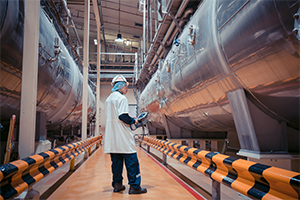Why concentrate on measuring quality issues when it’s too late to correct the problem? With artificial intelligence (AI), you can predict the final quality of your products and adjust the line in real time to achieve a more stable process.
With short lead-time production runs, just-in-time production, tightening delivery windows and compressed time-to-market deadlines, controlling quality while complying with strict regulations and standards is harder than ever, and companies can even open themselves to legal liabilities in case of an accident. Even when less than ideal products can still be sold, the image of the company can be substantially diminished, while its bottom line can be hampered by unexpected products’ recalls.
In the steelmaking sector for example, despite experience acquired since the beginning of metallurgy, the result is often unstable and inconsistent over time, and properties of the final material such as base aspect, mechanical and chemical properties always slightly differ, or worse. In its purest form, a typical continuous production process starts with raw materials, and applies a standardized recipe to fabricate a product with a defined quality, in a predetermined time. Real manufacturing is never that easy in practice. For steelmakers, this diverse product quality represents a huge challenge: if the product isn’t up to par, it must be reprocessed, or simply scrapped, which implies higher costs, lost time, and more machine usage.
Consistent output, whatever the input
This variation of production quality often depends on the heterogenous nature of the raw materials, even in the same batch, and in variables that cannot be controlled by the operators, such as the exterior temperature, the humidity, etc. Still, can’t we do anything when rule-based systems and classic engineering cannot compensate in real time for these conditions? “To obtain a constant high quality, companies can either invent new predefined recipes, or must dynamically change the existing recipe”, analyzes Jean-Philippe Hugo, CEO of Wizata. “Nowadays, recipes are highly complex and traditional methods aren’t enough to stay ahead of the competition: your engineers and operators need to be assisted by a new set of eyes, powered by an artificial intelligence that takes advantage of the predictive power in the data to know in advance the final product quality, and how to select the optimal parameters to achieve a better result.”
Training an AI to discover the optimal production settings
By identifying parameters that must be avoided because they cause substandard quality, and parameters leading to superior quality, the AI can predict emerging production faults and isolate the best values for every situation, for example the pressure, temperature and humidity of an oven. The goal is to identify preventive or prescriptive recommendations, actionable insights for parameters that can be modified in practice and applied by operators on the ground floor. A close collaboration between field experts and data scientists therefore yields the best return of investment, especially for future integration of these new insights in rule-based systems that govern production, or even automation systems.
Controlling for downstream effects
AI is uniquely positioned to solve problems that couldn’t be tackled previously. Not only does it have a clear and full view of the live production with a detailed comprehension of past data, it can reach conclusions by focusing on probabilities and statistics, without having to explicitly reconstruct new theories or fixed rules.
Assisted with AI, operators can better manage the settings of machines in real time, while engineers can define new recipes for an optimal production, even in delicate cases where minor differences can imply huge effects downstream. For engineers and R&D scientists, future processes can be further streamlined using AI for state-of-the-art root cause analysis and finding patterns in big data within virtual labs, leveraging the power of the cloud.
Want to learn more about quality sustainability through artificial intelligence? Discover our customer case with an international steel producer.


